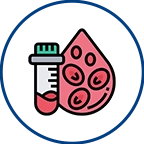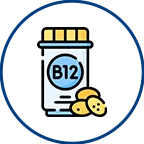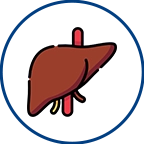Unveiling the Significance of Urobilinogen in Urine

Urine, a seemingly simple bodily fluid, carries a wealth of information about our health and wellbeing. Among the various components found in urine, urobilinogen stands out as a significant biomarker that offers valuable insights into our liver function and overall health. In this blog, we'll delve into the significance of urobilinogen in urine and understand its role as a diagnostic tool.
Understanding Urobilinogen
Urobilinogen is a colorless compound that forms during the breakdown of bilirubin, a yellow pigment derived resulting from red blood cell haemoglobin degradation. Hemoglobin, the substance that carries oxygen in the blood, deteriorates as old blood cells are replaced by new ones. This process releases bilirubin, which is eventually converted into urobilinogen in the intestines.
The majority of urobilinogen produced is further metabolized in the intestines and then eliminated from the body in feces. However, only a little amount of urobilinogen is discharged into the urine by the kidneys and reabsorbed into the bloodstream. Urobilinogen detection thus offers invaluable insights into many physiological processes and probable medical conditions.
Home Sample Collection
Significance as a Diagnostic Tool
Liver Function: The presence of urobilinogen in urine serves as an indicator of liver function. An increase in urobilinogen levels may suggest impaired liver function, as the liver is responsible for processing bilirubin and excreting it in bile. Conditions such as hepatitis, cirrhosis, and other liver disorders can lead to a buildup of bilirubin, resulting in elevated levels of urobilinogen in urine.
Hemolytic Disorders: Urobilinogen levels can also provide insights into hemolytic disorders, where red blood cells are prematurely broken down. Increased breakdown of red blood cells leads to higher bilirubin production, which in turn elevates urobilinogen levels. Conditions like hemolytic anemia and certain genetic disorders can lead to this pattern.
Biliary Obstruction: Urobilinogen levels can be used to identify biliary obstructions, where the flow of bile from the liver to the intestines is blocked. Since bilirubin is unable to reach the intestines, less urobilinogen is produced and excreted. This results in reduced urobilinogen levels in urine. Biliary obstructions can be caused by gallstones, tumors, or other issues affecting the bile ducts.
Urinary Tract Infections: In some cases, urinary tract infections (UTIs) can impact urobilinogen levels. UTIs can affect the composition of urine and alter urobilinogen excretion. However, urobilinogen levels are not typically the primary focus when diagnosing UTIs.
Interpreting Urobilinogen Levels
Interpreting urobilinogen levels in urine requires a comprehensive understanding of the patient's medical history, symptoms, and other diagnostic tests. Urobilinogen is usually measured through a urinalysis, which is a common component of routine medical check-ups and the diagnostic process for various conditions.
It's important to note that urobilinogen levels can fluctuate due to factors such as diet, medications, and hydration status. Therefore, any interpretation of urobilinogen levels should be done in conjunction with other relevant clinical information.
Conclusion
Urobilinogen, though often overlooked, plays a crucial role in providing insights into liver function, hemolytic disorders, and biliary obstructions. As a component of urine, it offers a non-invasive and easily accessible method for assessing various health conditions. While elevated or decreased urobilinogen levels can raise concerns, they are valuable clues that prompt further investigation into potential underlying issues. Regular medical check-ups, along with proper diagnostic tests and professional guidance, are essential in accurately interpreting urobilinogen levels and maintaining overall health.
Frequently Asked Questions
What is urobilinogen, and why is it significant in urine?
Urobilinogen is a colorless compound formed during the breakdown of bilirubin, which results from the degradation of hemoglobin in red blood cells. It is significant in urine because it serves as a marker for liver function and various health conditions. Elevated or decreased levels of urobilinogen can indicate issues such as liver disorders, hemolytic disorders, and biliary obstructions.
How is urobilinogen produced in the body?
Urobilinogen is produced through the breakdown of bilirubin in the intestines. Bilirubin is released as a result of the natural turnover of red blood cells. The breakdown of bilirubin produces urobilinogen, which is then excreted in both feces and urine.
What role does urobilinogen play in diagnosing liver disorders?
Urobilinogen levels in urine are indicative of liver function. Elevated urobilinogen levels can be associated with liver disorders such as hepatitis and cirrhosis. The liver's ability to process bilirubin is compromised in these conditions, leading to increased levels of both bilirubin and urobilinogen in the bloodstream.
How are hemolytic disorders related to urobilinogen in urine?
Hemolytic disorders involve the premature breakdown of red blood cells. This increased breakdown leads to higher bilirubin production, which in turn results in elevated urobilinogen levels in urine. Conditions like hemolytic anemia and certain genetic disorders can cause these elevated levels.
Can urobilinogen levels in urine detect biliary obstructions?
Yes, urobilinogen levels can help identify biliary obstructions. Biliary obstructions prevent bilirubin from reaching the intestines, leading to reduced urobilinogen production and excretion. Conditions such as gallstones or tumors can block the flow of bile from the liver, resulting in lower urobilinogen levels in urine.
How are urobilinogen levels measured in urine?
Urobilinogen levels are typically measured through a urinalysis, which is a common component of routine medical check-ups. A dipstick test or laboratory analysis of a urine sample helps quantify the amount of urobilinogen present.
Can factors like diet or medications influence urobilinogen levels in urine?
Yes, urobilinogen levels can be influenced by factors such as diet, certain medications, and hydration status. Eating foods rich in red pigments, like beets, can temporarily affect urine color and urobilinogen levels. Medications and hydration can also impact urobilinogen excretion, so it's important to consider these factors when interpreting test results.
Are urobilinogen levels a primary indicator of urinary tract infections (UTIs)?
Urobilinogen levels are not typically a primary indicator of UTIs. UTIs are usually diagnosed through symptoms, urine culture, and other specific tests. However, UTIs can alter the composition of urine, potentially affecting urobilinogen levels indirectly.
How should one interpret changes in urobilinogen levels over time?
Interpreting changes in urobilinogen levels requires considering the individual's medical history, symptoms, and overall clinical picture. Significant changes might warrant further investigation by a healthcare professional to identify potential underlying causes.
Can urobilinogen levels be used for ongoing health monitoring?
Yes, urobilinogen levels can be used as part of ongoing health monitoring, especially for individuals with known liver conditions, hemolytic disorders, or other related health concerns. Regular urinalysis can help track any fluctuations in urobilinogen levels, providing valuable insights into the patient's health status.
Book Your Slot
Our Locations Near You in Hyderabad
3KM from Banjara Hills
1.9KM from Yusufguda
3KM from Madhura Nagar
5KM from Shaikpet
Profiles
- Cardiac Risk Profile
- Pituitary marker Profile
- Rheumatoid Arthritis Profile
- Dengue Fever Panel
- Lung Cancer Panel 1 Complete Molecular
- Gastroenteritis Screening Panel
- Thyroid Profile (T3,T4,TSH), Serum
- Pancreatic Marker Profile
- STD profile
- Androgen Profile
- Lipid Profile, Serum
- Pancreatic(acute)Profile
- PCOD Profile
Radiology
Pathology Tests
- Glucose Fasting (FBS),Sodium Fluoride Plasma
- Creatinine, Serum
- Glycosylated Hemoglobin (HbA1C)
- Vitamin B12 (Cyanocobalamin), Serum
- Thyroid Stimulating Hormone (TSH) Ultrasensitive, Serum
- Complete Urine Examination (CUE), Urine
- Liver Function Test (LFT),Serum
- Dengue (IgG & IgM), Serum
- Dengue Antigen (Ns1) Rapid, Serum
- C-Reactive Protein (CRP), Serum
- Widal (Slide Method), Serum
- Total IgE, Serum




